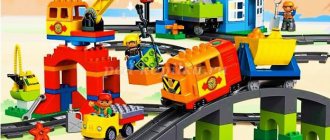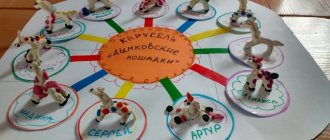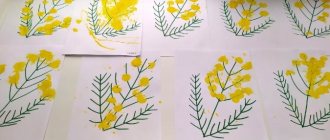Morning conversations in the middle group
In accordance with the Federal State Educational Standard, a conversation with children on a given topic is the most effective educational way of interacting with a child. Morning conversation in kindergarten is a certain stage of preparing the child for school everyday life.
Note! The conversation should be prepared in such a way that the child, on the one hand, receives initial knowledge, and, on the other hand, goes through the process of socialization.
The topics of morning conversations and lessons may vary. However, at the moment there are card indexes with recommended topics for discussion.
Consideration of the situation in the preschool educational institution
Summary of the conversation “My beloved mother”
Summary of the conversation “My beloved mother”
Software tasks:
To develop in children a kind attitude and love for their mother. Teach children to answer the teacher's questions. To evoke a feeling of pride and joy for the deeds and actions of a loved one, a feeling of gratitude for caring.
Preliminary work:
reading stories, poems, using finger games; looking at a photo album with photographs of mothers; listening to a song about mom on an audio cassette.
Progress of the conversation:
-Guys, who brought you to kindergarten today? And yet, most of the children were brought by their mothers.
- Guys, let's talk together about the person closest to you. Can you name it?
- Of course it’s mom! Do all children know the names of their mothers? ( Children answer
). What beautiful names your mothers have.
– Guys, your mothers not only have different names, but also different appearances. How do you recognize your mother? ( My mother is tall, short, she has kind, blue eyes, black, dark, blond hair
).
– Of course, your mothers are different. They have different names, appearances and clothes, but there are some things in which they are very similar.
-When your mother hugs you and kisses you. What is she like?
– When does mom dress fashionably? What is she like?
-When mom doesn’t scold you when you’re naughty. What is she like?
-When mom laughs and smiles. What is she like?
-And if you love your mother, what is she like?
– What are your mothers like?
– And your mothers are also very hardworking. In this they are all very similar to each other. – What can your mothers do? ( Children's answers
).
- Guys, who has already learned to help mom? ( Children's answers
).
- Well done! Mothers are glad that they have such wonderful children.
– What tender and affectionate words do your mothers call you?
– Mothers love to compare their children with anyone. Who do your mothers compare you to? ( Children's answers
).
- That's how many words your mothers come up with.
– What games do your mothers play with you? ( Children's answers
).
- It’s so good, guys, that you have such kind mothers who love you.
-Do you know that not only people have mothers, but also animals and birds. They are as caring, gentle and affectionate as your mothers. All mothers take care of their children, even birds (bird show).
- Who is the chicken? At the duck's? The turkey? Etc.
Look at the pictures and guess where and whose children are (showing wild animals).
Who is the she-wolf? Who's with the bear? Who is the hare? AND . etc.
Wild animals live in the forest. And their mothers teach them to get their own food.
- Squirrel teaches who? Why?
-The hare teaches whom? Why?
And they are all very similar to their mothers.
Game “What our mothers taught us...”
- Guys, show me how your mothers taught you a little of everything. Children show movements (washing themselves, eating with a spoon, clapping their hands, stomping their feet, walking, sticking out their legs, jumping, combing their hair).
- Guys, what should we say to our mothers for teaching us everything? (“Mommy, thank you”). Well done boys!
Card index of conversations in the middle group
Usually thematic blocks are included in the outline:
- Day of Knowledge;
- autumn;
- well-being;
- professions;
- safety;
- health;
- kindness;
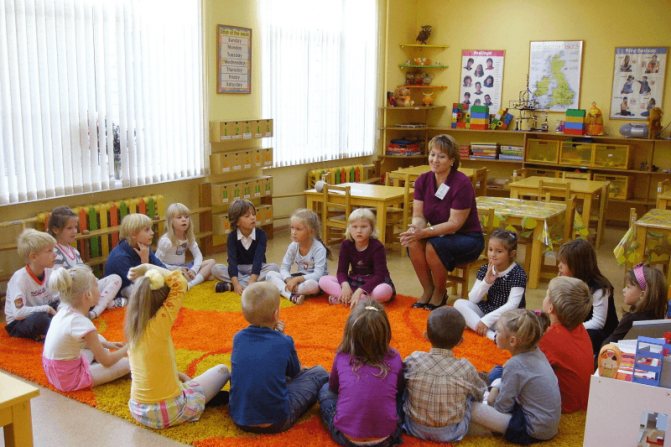
Dialogue in preschool educational institutions
- family;
- my city;
- transport;
- famous people;
- culture;
- emotions;
- New Year;
- nature;
- boys and girls;
- defenders of the fatherland, military specialties;

New Year theme
- design;
- Easter;
- guests;
- Mother;
- space;
- folk art;
- spring, winter;
- Victory Day;
- Emotional behavior;
- sport;
- morning;
- Street;
- summer.
Note! All these topics are related to the events that children experience and the environment in which they grow up.
Conversation with children of the middle group: life safety
The main goal of the dialogue on life safety is to explain to children the fact that even simple things can be fraught with danger and must be handled with care. When talking with children, you should pay attention to dangerous objects surrounding children at home. Among these dangers are:
- The presence of piercing and cutting objects in large quantities in everyday life (scissors, needles, pins, etc.). The emphasis should be on the fact that all these things must be stored in the proper place.
- Availability of household chemicals. It is important to convey to children that although powders, insect repellents, dishwashing detergents and other household chemicals may often be attractively packaged, they should not be eaten.
- Medications. The goal is to explain to children that they need to take pills only when there is a medical indication. In everyday life, the use of medications (even beautiful tablets and tasty syrups) can adversely affect your health.
- Electrical appliances. Common household appliances may cause fire or electric shock.
During this conversation, we can mention flammable Christmas tree decorations and garlands.
Also, during the conversation on life safety, the importance of such special services as ambulance, police and firefighters should be touched upon. It is necessary to clearly explain the purpose of each of them:
- ambulance - a doctor is required;
- firefighters - the fire is raging;
- police - we need to protect life in a dangerous situation and ensure law and order.
Note! Fires need to be addressed as a separate topic in this series. Children need to be told about the causes of fires and the actions that need to be taken in an emergency. Explain that you cannot play with fire, and this can lead to very sad consequences.
Conversation about mother in the middle group
Mom is the most important person in a child’s life. In childhood, you need to develop a sense of respect for women, love for your family and friends. It is advisable to organize such a dialogue on holidays such as Mother’s Day or International Women’s Day.
During such conversations, children should be given a lot of interaction:
- tell poems about mommy;
- call mothers with kind and gentle words;
- offer options for helping mom.

Talk about mom
All this can be combined with numbers and skits that children rehearse for their mothers and then show them. This will help children learn to demonstrate their feelings and receive maternal warmth and care.
Conversation about professions in the middle group
During such a conversation, the main goal is to form and consolidate children’s ideas about various professions. Particular attention should be paid to such professions as:
- teachers;
- doctors;
- engineers;
- sellers and others.
Drawing lessons by design for middle and senior kindergarten groups
This conversation is most effective in the format of an interactive journey through the stations. At each station, children get to know the specifics of one profession in a playful way. During their stay at the station, the children try to guess what kind of profession the teacher is presenting to them. Then they talk about what the profession does.
Note! You can organize a small master class, during which children will immerse themselves in the atmosphere of the profession.
A particularly important element is the discussion of professions in the middle group. At this stage, the student already understands what adults do. He shows interest in their activities. Through the study of professions, the child forms his ideas about the world, learns to respect and appreciate the work of other people. In addition, this is the first stage of vocational guidance, at which the child shows individual inclinations and interests.
Conversations about health in the middle group
The purpose of the conversation should be to develop children’s initial skills about protecting life and health. Children must learn to draw conclusions about the safety of a particular action.
It is necessary to develop in them a sense of mutual assistance and mutual assistance. During the conversation, it is worth determining exactly how children understand the very concept of “health” and conveying that health is human wealth. It is important to discuss with children those situations in which they can harm their health.
Note! In a conversation about health, it is worth including a minute of physical education and a discussion of nutrition culture. After all, the formation of a healthy body depends on a balanced diet.c
Another important aspect to consider during the discussions in this unit is personal hygiene. An excellent tool for this is the work “Moidodyr”.

Transport topics
Topic "Transport" in the middle group
A conversation on this topic is intended to help systematize children’s ideas regarding the methods and characteristics of people’s movement.
You need to talk to your children about several main aspects of this topic:
- highlight the purposes for which transport is used;
- present a classification of modes of transport.
Pictures, videos, presentations and toys can be used as supporting material.
Note! Demonstration material must be clearly prepared.
Conversation about pets in the middle group
The main goals of conducting such a conversation from a cognitive point of view:
- deepen children's knowledge about pets;
- to form the concept of “pets” in the minds of the younger generation;
- to cultivate love and the ability to care for our smaller brothers.
This lesson involves examining illustrative material, discussing the basic habits of pets, their benefits and purpose, as well as the rules for handling pets. Children can be told interesting facts about each pet to capture their attention and begin to develop an interest in biology.
Conversations on healthy lifestyle in the middle group
This series of conversations is closely intertwined with conversations about health. During them, children are taught the basics of biology - the human body is studied, children get acquainted with the main functions and organs of a person, and try to understand why each of them is needed. Also, in a playful form, material is presented about those factors that have a detrimental effect on human health.
The purpose of the classes is to develop in the student the value of a healthy lifestyle, nutritional culture, and sports.
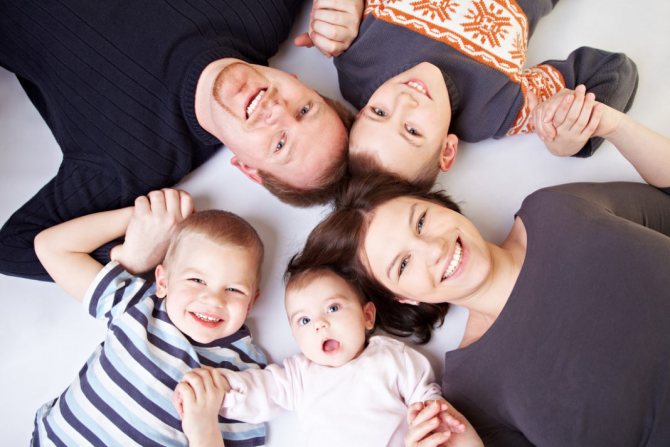
Family theme
Conversations about family in the middle group
Children should receive a formed idea of what a family is and how valuable it is in everyone’s life.
Creative non-traditional drawing techniques for kindergarten
It is important to convey to the little ones that families are different, large and small. At the same time, it is the family that is the support in every person’s life.
During these conversations, as an interactive activity, you can invite children to look at photographs and write short stories about their families. Such an activity will favor the development of the speech apparatus and the ability to express thoughts coherently.
Note! You can supplement the lesson by reading and learning short works about family and relatives. This will also have a beneficial effect on the development of children's memory.
Conversations about safety in the middle group
They need to be done with children regularly.
During such conversations, you need to touch on several blocks of topics:
- weather conditions (ice, rain, extreme cold or heat);
- traffic rules (traffic rules);
- plants, mushrooms and animals (insects, dogs, poisonous mushrooms, etc.).
Such conversations are best conducted in the format of situational discussion. This will help immerse children in the real world and help them orient themselves in the future. Children will analyze a specific situation, which will develop critical thinking. You can supplement the conversation with demonstration material, coloring/drawing, as well as poems and sayings.
Children's conversations about autumn in the middle group
A conversation about autumn will teach children to see the connection between the length of daylight hours, climate indicators, as well as the behavior of animals and plants. Such a conversation will contribute to the formation of a caring attitude towards flora and fauna. Will teach you to distinguish the autumn months from the spring (March, April, May) and winter (December, January and February).
This is one of the most favorable conversation topics for introducing a student to literature. There are a huge number of easy-to-understand poems that children can learn by heart. Also, using autumn pictures, you can teach children to compose their own texts, which has a beneficial effect on children’s speech culture.
Situational conversation in the middle group
Conversations with children are most often based on a situational approach. During the discussion of a given topic, children are actively involved in its discussions and consider examples of situations that arise in their connection.
Also an important element of raising children is situational conversation, that is, one that arises to discuss a specific situation or event. Most often, it is quite topical and serves as a way for the child to understand the world and the events taking place in it. This is like a replacement for a news program for children.
Conversations held with children have multi-purpose themes and cover a fairly wide range of topics. These topics are related to the basics of life in society, knowledge of the world, and safe existence in society.
At the age of a child in the middle group, the form of conversations is one of the most effective teaching methods. During a conversation, the baby expands his knowledge about the world and gets the opportunity to socialize. In addition, conversations have a beneficial effect on the development of speech culture, the ability to express one’s opinion and defend it. During the conversations, the child’s vocabulary develops, ideas about morality and ethics, and rules of behavior in society are instilled. The child develops comprehensively as a person.

